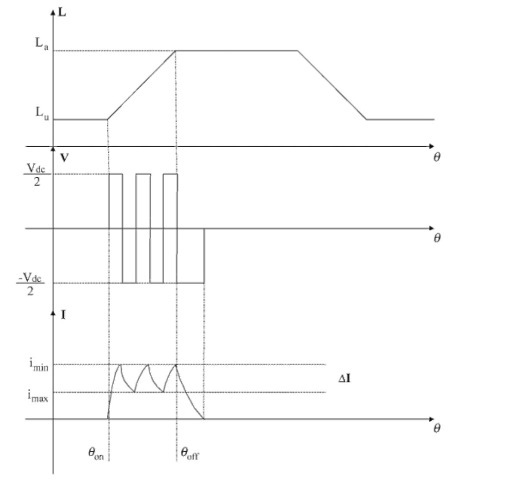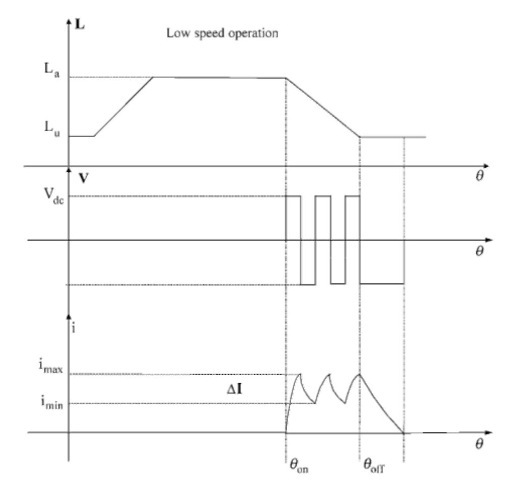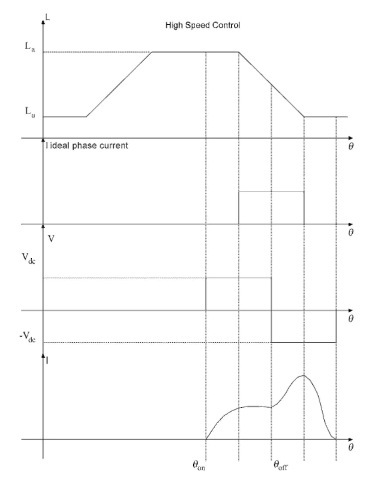9.8
This is the operating mode of the switched reluctance generator (SRG) or the regenerative mode of a switched reluctance motor (SRM) when the drive is a two-quadrant or four-quadrant drive. In order to have a generating mode of operation, each phase is excited when the rotor is at the aligned position. In fact, the current pulse is provided during the negative slope of the phase inductance. Figures

FIGURE 9.56 Phase inductance, voltage, and current for split-DC converter.
9.57 and 9.58 show the phase inductance, voltage, and current for low-speed (hysteresis or bang-bang control) and high-speed (single-pulse) operations, respectively.
The SRG has low radial vibrations as the stator phases are excited from the aligned to unaligned position; also there is absence of significant phase current. The presence of a large machine time constant also brings small radial forces. The use of antivibration configurations helps to further reduce the vibration. The radial forces being position dependent, the magnitude of the attractive forces is less and the absence of sudden changes in the rate of change

FIGURE 9.57 Phase inductance, voltage, and current for low-speed operation in generating mode.
of radial force in an SRG reduces the vibration to a large extent. Current profiling greatly reduces the noise level in an SRG, but it leads to lower performance levels.
The switched reluctance machine is unique in its operation as generator in that it does not require a permanent magnet or field windings on the rotor. The phase independence characteristic of the machine makes it extremely fault tolerant for critical applications. The absence of permanent magnets in these machines eliminates the problem of fire hazard of the machine generating into a shorted winding, compared to permanent magnet machines wherein one cannot turn off excitation. This unique feature makes the SRG a good candidate for various industrial and automotive applications.
A switched reluctance machine is operated in the generating mode by positioning phase current pulses during the periods where

FIGURE 9.58 Phase inductance, ideal current, voltage, and current for high-speed operation in generating mode.
the rotor is positioned such that the phase inductance is decreasing. This occurs immediately after rotor and stator poles have passed alignment. Here, the machine obtains excitation from the same voltage source to which it generates power. Typically, a phase is turned on before a rotor pole aligns with that phase, drawing current from the DC source to excite the phase. Once the rotor poles pass alignment with the phase stator poles, the winding is disconnected from the DC source. It then generates into the same source with suitable connected diodes. The work done by the mechanical system to pull the rotor poles away from the stator poles is returned to the DC source. The DC source returns the excitation power plus the generated power. The control key is to position the phase current pulses to the phase stator poles in order to maximize the efficiency and to reduce the stresses on the power electronic switches. The phase current pulses during the generating mode are the mirror images of the phase current pulses in the motoring mode of operation.
An SRG is excited through a common asymmetric bridge. In a classic two-switch converter, one phase of this inverter uses the same DC source for exciting each SRG phase through two controllable switches and demagnetizing the same phase through the diodes. The conduction angle or dwell angle is the interval in which the phase is excited. Phase excitations depend on turn-on and turn-off angles. Invertors, switches, and diodes should be designed to support maximum DC source voltage and maximum phase current. Maximum voltage occurs when a switch reluctance machine operates as a generator. Main high-speed applications of SRGs are starter/alternators for automotive electrical systems and power generation in aerospace applications. The main low-speed application of SRG is for wind turbines.
GENERATIVE MODE OF OPERATION (Electric Motor)
Next post: ENERGY CONVERSION CYCLE (Electric Motor)
Previous post: ADVANTAGES AND DISADVANTAGES (Electric Motor)
